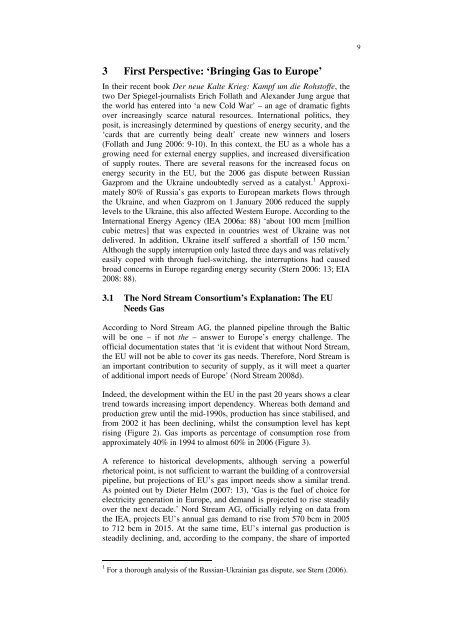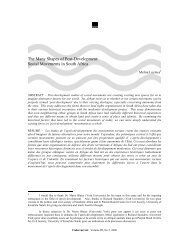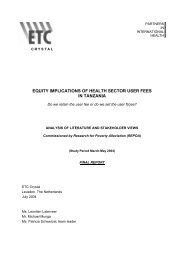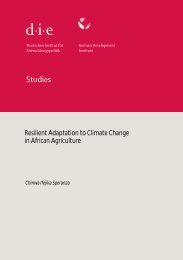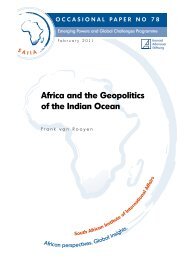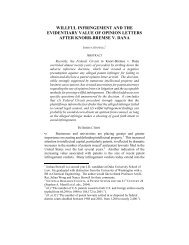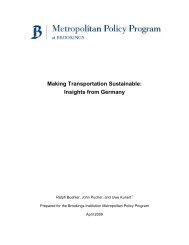Nord Stream: Not Just a Pipeline
Nord Stream: Not Just a Pipeline
Nord Stream: Not Just a Pipeline
You also want an ePaper? Increase the reach of your titles
YUMPU automatically turns print PDFs into web optimized ePapers that Google loves.
3 First Perspective: ‘Bringing Gas to Europe’<br />
In their recent book Der neue Kalte Krieg: Kampf um die Rohstoffe, the<br />
two Der Spiegel-journalists Erich Follath and Alexander Jung argue that<br />
the world has entered into ‘a new Cold War’ – an age of dramatic fights<br />
over increasingly scarce natural resources. International politics, they<br />
posit, is increasingly determined by questions of energy security, and the<br />
‘cards that are currently being dealt’ create new winners and losers<br />
(Follath and Jung 2006: 9-10). In this context, the EU as a whole has a<br />
growing need for external energy supplies, and increased diversification<br />
of supply routes. There are several reasons for the increased focus on<br />
energy security in the EU, but the 2006 gas dispute between Russian<br />
Gazprom and the Ukraine undoubtedly served as a catalyst. 1 Approximately<br />
80% of Russia’s gas exports to European markets flows through<br />
the Ukraine, and when Gazprom on 1 January 2006 reduced the supply<br />
levels to the Ukraine, this also affected Western Europe. According to the<br />
International Energy Agency (IEA 2006a: 88) ‘about 100 mcm [million<br />
cubic metres] that was expected in countries west of Ukraine was not<br />
delivered. In addition, Ukraine itself suffered a shortfall of 150 mcm.’<br />
Although the supply interruption only lasted three days and was relatively<br />
easily coped with through fuel-switching, the interruptions had caused<br />
broad concerns in Europe regarding energy security (Stern 2006: 13; EIA<br />
2008: 88).<br />
3.1 The <strong>Nord</strong> <strong>Stream</strong> Consortium’s Explanation: The EU<br />
Needs Gas<br />
According to <strong>Nord</strong> <strong>Stream</strong> AG, the planned pipeline through the Baltic<br />
will be one – if not the – answer to Europe’s energy challenge. The<br />
official documentation states that ‘it is evident that without <strong>Nord</strong> <strong>Stream</strong>,<br />
the EU will not be able to cover its gas needs. Therefore, <strong>Nord</strong> <strong>Stream</strong> is<br />
an important contribution to security of supply, as it will meet a quarter<br />
of additional import needs of Europe’ (<strong>Nord</strong> <strong>Stream</strong> 2008d).<br />
Indeed, the development within the EU in the past 20 years shows a clear<br />
trend towards increasing import dependency. Whereas both demand and<br />
production grew until the mid-1990s, production has since stabilised, and<br />
from 2002 it has been declining, whilst the consumption level has kept<br />
rising (Figure 2). Gas imports as percentage of consumption rose from<br />
approximately 40% in 1994 to almost 60% in 2006 (Figure 3).<br />
A reference to historical developments, although serving a powerful<br />
rhetorical point, is not sufficient to warrant the building of a controversial<br />
pipeline, but projections of EU’s gas import needs show a similar trend.<br />
As pointed out by Dieter Helm (2007: 13), ‘Gas is the fuel of choice for<br />
electricity generation in Europe, and demand is projected to rise steadily<br />
over the next decade.’ <strong>Nord</strong> <strong>Stream</strong> AG, officially relying on data from<br />
the IEA, projects EU’s annual gas demand to rise from 570 bcm in 2005<br />
to 712 bcm in 2015. At the same time, EU’s internal gas production is<br />
steadily declining, and, according to the company, the share of imported<br />
1 For a thorough analysis of the Russian-Ukrainian gas dispute, see Stern (2006).<br />
9


